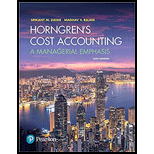
EBK HORNGREN'S COST ACCOUNTING
16th Edition
ISBN: 9780134475998
Author: Rajan
Publisher: YUZU
expand_more
expand_more
format_list_bulleted
Textbook Question
Chapter 19, Problem 19.30P
Quality improvement, Pareto diagram, cause-and-effect diagram. Pauli’s Pizza has recently begun collecting data on the quality of its customer order processing and delivery. Pauli’s made 1,800 deliveries during the first quarter of 2017. The following quality data pertain to first-quarter deliveries:
| Type of Quality Failure | Quality Failure Incidents, First Quarter 2017 |
| Late delivery | 50 |
| Damaged or spoiled product delivered | 5 |
| Incorrect order delivered | 12 |
| Service complaints by customer of delivery personnel | 8 |
| Failure to deliver incidental items with order (drinks, side items, etc.) | 18 |
- 1. Draw a Pareto diagram of the quality failures experienced by Pauli’s Pizza.
Required
- 2. Give examples of prevention activities that could reduce the failures experienced by Pauli’s.
- 3. Draw a cause-and-effect diagram of possible causes for late deliveries.
Expert Solution & Answer
Want to see the full answer?
Check out a sample textbook solution
Students have asked these similar questions
None
Abc
Ans
Chapter 19 Solutions
EBK HORNGREN'S COST ACCOUNTING
Ch. 19 - Describe two benefits of improving quality.Ch. 19 - Prob. 19.2QCh. 19 - Name two items classified as prevention costs.Ch. 19 - Give two examples of appraisal costs.Ch. 19 - Distinguish between internal failure costs and...Ch. 19 - Describe three methods that companies use to...Ch. 19 - Companies should focus on financial measures of...Ch. 19 - Give two examples of nonfinancial measures of...Ch. 19 - Give two examples of nonfinancial measures of...Ch. 19 - When evaluating alternative ways to improve...
Ch. 19 - Distinguish between customer-response time and...Ch. 19 - Prob. 19.12QCh. 19 - Give two reasons why delays occur.Ch. 19 - Companies should always make and sell all products...Ch. 19 - Prob. 19.15QCh. 19 - Rector Corporation is examining its quality...Ch. 19 - Six Sigma is a continuous quality improvement...Ch. 19 - Costs of quality. (CMA, adapted) Osborn, Inc.,...Ch. 19 - Costs of quality analysis. Adirondack Company...Ch. 19 - Costs-of-quality analysis. Safe Travel produces...Ch. 19 - Costs of quality, quality improvement. iCover...Ch. 19 - Prob. 19.22ECh. 19 - Prob. 19.23ECh. 19 - Waiting time. Its a Dogs World (IDW) makes toys...Ch. 19 - Waiting time, service industry. The registration...Ch. 19 - Waiting time, cost considerations, customer...Ch. 19 - Nonfinancial measures of quality and time. For the...Ch. 19 - Nonfinancial measures of quality, manufacturing...Ch. 19 - Statistical quality control. Harvest Cereals...Ch. 19 - Quality improvement, Pareto diagram,...Ch. 19 - Quality improvement, relevant costs, and relevant...Ch. 19 - Quality improvement, relevant costs, and relevant...Ch. 19 - Waiting times, manufacturing cycle times. The...Ch. 19 - Prob. 19.34PCh. 19 - Manufacturing cycle times, relevant revenues, and...Ch. 19 - Compensation linked with profitability, waiting...Ch. 19 - Ethics and quality. Weston Corporation...Ch. 19 - Prob. 19.38P
Knowledge Booster
Learn more about
Need a deep-dive on the concept behind this application? Look no further. Learn more about this topic, accounting and related others by exploring similar questions and additional content below.Similar questions
- Hi expert provide answerarrow_forwardHow much long term debt did the firm have?arrow_forwardWildhorse Windows manufactures and sells custom storm windows for three-season porches. Wildhorse also provides installation service for the windows. The installation process does not involve changes in the windows, so this service can be performed by other vendors. Wildhorse enters into the following contract on July 1, 2025, with a local homeowner. The customer purchases windows for a price of $2,650 and chooses Wildhorse to do the installation. Wildhorse charges the same price for the windows irrespective of whether it does the installation or not. The customer pays Wildhorse $1,988 (which equals the standalone selling price of the windows, which have a cost of $1,230) upon delivery and the remaining balance upon installation of the windows. The windows are delivered on September 1, 2025, Wildhorse completes installation on October 15, 2025, and the customer pays the balance due. (a) Wildhorse estimates the standalone selling price of the installation based on an estimated cost of…arrow_forward
arrow_back_ios
SEE MORE QUESTIONS
arrow_forward_ios
Recommended textbooks for you
 Managerial AccountingAccountingISBN:9781337912020Author:Carl Warren, Ph.d. Cma William B. TaylerPublisher:South-Western College Pub
Managerial AccountingAccountingISBN:9781337912020Author:Carl Warren, Ph.d. Cma William B. TaylerPublisher:South-Western College Pub Cornerstones of Cost Management (Cornerstones Ser...AccountingISBN:9781305970663Author:Don R. Hansen, Maryanne M. MowenPublisher:Cengage Learning
Cornerstones of Cost Management (Cornerstones Ser...AccountingISBN:9781305970663Author:Don R. Hansen, Maryanne M. MowenPublisher:Cengage Learning Managerial Accounting: The Cornerstone of Busines...AccountingISBN:9781337115773Author:Maryanne M. Mowen, Don R. Hansen, Dan L. HeitgerPublisher:Cengage Learning
Managerial Accounting: The Cornerstone of Busines...AccountingISBN:9781337115773Author:Maryanne M. Mowen, Don R. Hansen, Dan L. HeitgerPublisher:Cengage Learning Auditing: A Risk Based-Approach (MindTap Course L...AccountingISBN:9781337619455Author:Karla M Johnstone, Audrey A. Gramling, Larry E. RittenbergPublisher:Cengage Learning
Auditing: A Risk Based-Approach (MindTap Course L...AccountingISBN:9781337619455Author:Karla M Johnstone, Audrey A. Gramling, Larry E. RittenbergPublisher:Cengage Learning Essentials of Business Analytics (MindTap Course ...StatisticsISBN:9781305627734Author:Jeffrey D. Camm, James J. Cochran, Michael J. Fry, Jeffrey W. Ohlmann, David R. AndersonPublisher:Cengage Learning
Essentials of Business Analytics (MindTap Course ...StatisticsISBN:9781305627734Author:Jeffrey D. Camm, James J. Cochran, Michael J. Fry, Jeffrey W. Ohlmann, David R. AndersonPublisher:Cengage Learning

Managerial Accounting
Accounting
ISBN:9781337912020
Author:Carl Warren, Ph.d. Cma William B. Tayler
Publisher:South-Western College Pub

Cornerstones of Cost Management (Cornerstones Ser...
Accounting
ISBN:9781305970663
Author:Don R. Hansen, Maryanne M. Mowen
Publisher:Cengage Learning

Managerial Accounting: The Cornerstone of Busines...
Accounting
ISBN:9781337115773
Author:Maryanne M. Mowen, Don R. Hansen, Dan L. Heitger
Publisher:Cengage Learning

Auditing: A Risk Based-Approach (MindTap Course L...
Accounting
ISBN:9781337619455
Author:Karla M Johnstone, Audrey A. Gramling, Larry E. Rittenberg
Publisher:Cengage Learning

Essentials of Business Analytics (MindTap Course ...
Statistics
ISBN:9781305627734
Author:Jeffrey D. Camm, James J. Cochran, Michael J. Fry, Jeffrey W. Ohlmann, David R. Anderson
Publisher:Cengage Learning
Inspection and Quality control in Manufacturing. What is quality inspection?; Author: Educationleaves;https://www.youtube.com/watch?v=Ey4MqC7Kp7g;License: Standard youtube license